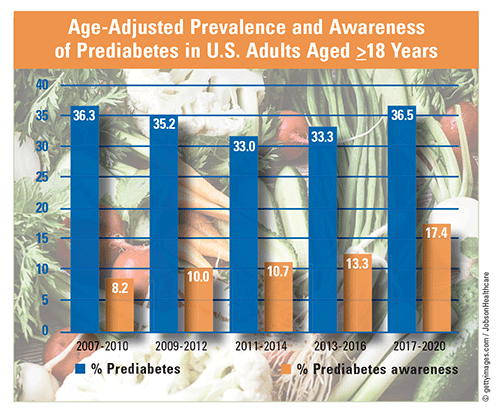US Pharm. 2022;47(11):14.
The American Diabetes Association (ADA) defines prediabetes as the presence of impaired fasting glucose (IFG; 100-125 mg/dL) or impaired glucose tolerance (IGT; 2-hour plasma glucose 140-199 mg/dL after 75-g oral glucose tolerance test) or an A1C level of 5.7% to 6.4%. Although the definition of prediabetes has changed over the years, concerns regarding the potential consequences of this condition have not. Up to 70% of individuals with prediabetes will eventually develop type 2 diabetes (T2D), and without preventative interventions such as healthy eating and physical activity, many will progress to T2D within 5 years.

Prevalence and Awareness: The National Center for Chronic Disease Prevention and Health Promotion notes that approximately 96 million U.S. adults aged 18 years and older (38% of the adult population) have prediabetes, and nearly 80% of them are unaware that they have it. The most recent data from the National Diabetes Statistics Report, National Health and Nutrition Examination Survey, and CDC highlight national trends in prediabetes prevalence and awareness. Between 2013 and 2020, the prevalence of prediabetes increased 3.5% overall in adults aged 18 years and older. Prediabetes rates increased from 38% to 41% for men and from 31% to 32% for women. Prediabetes awareness increased from 11.4% to 15.9% among men, but dropped slightly—from 19.8% to 19.4%—among women. In addition, prediabetes prevalence among white, black, and Asian adults increased by 1.8%, 1.7%, and 4%, respectively, while decreasing by 0.8% among Hispanic adults between 2013 and 2020. During this time period, prediabetes awareness increased 0.2% among white adults, 2.9% among black adults, 19% among Asian adults, and 9% among Hispanic adults.
Risk Factors: The strongest risk factors for prediabetes in adults are overweight and obesity. Older age, family history of diabetes, history of gestational diabetes and/or polycystic ovarian syndrome, history of hypertension (140/90 mmHg or greater, or on therapy) and/or cardiovascular disease, history of dyslipidemia (HDL exceeding 35 mg/dL and/or triglycerides exceeding 250 mg/dL), high-risk race/ethnicity (American Indian/Alaskan Native, Hispanic/Latino, black, and Asian), and physical inactivity may also increase the risk of prediabetes and progression to T2D.
Screening: The U.S. Preventative Services Task Force currently recommends screening for prediabetes in adults aged 35 to 70 years who are overweight or obese. Similarly, the 2022 ADA Standards of Medical Care in Diabetes advises screening all adults aged 35 years and older regardless of risk factors, and adults of any age who are overweight or obese with one or more risk factors. In addition to IFG, IGT, or A1C measurements, the ADA/CDC Prediabetes Risk Test is available at www.cdc.gov/prediabetes/takethetest for use by clinicians and the public.
The content contained in this article is for informational purposes only. The content is not intended to be a substitute for professional advice. Reliance on any information provided in this article is solely at your own risk.
To comment on this article, contact rdavidson@uspharmacist.com.





